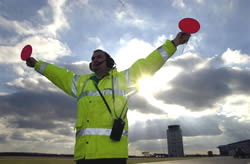The Cambridge-MIT Institute (CMI) has launched a unique project to design a 'silent' aircraft. CMI's 'Silent Aircraft' project has a bold aim: to discover ways to reduce aircraft noise dramatically, to the point where it would be virtually unnoticeable to people outside the airport perimeter.

This initiative is bringing together leading academics from Cambridge University and the Massachusetts Institute of Technology (MIT) with representatives from all parts of the civil aerospace/aviation industry. This unique community will be working together, sharing knowledge and developing the design for an aircraft whose noise emissions would barely be heard above the background noise level in a typical built-up area.
Partners in the project include British Airways, the Civil Aviation Authority, regional aerospace company Marshall of Cambridge, and National Air Traffic Services. They also include Rolls-Royce plc, which has made available its multi-million pound suite of design and analysis tools to help the research. Additionally, the project team plans to include representatives of community groups opposed to aircraft noise.
CMI's 'Silent Aircraft' initiative is one of four new Knowledge Integration Communities (KICs) that CMI is setting up this autumn. These KICs aim to find new ways in which academia and industry can work together and exchange knowledge to push forward research in areas where UK industry has a demonstrable competitive position - like aerospace. The Silent Aircraft KIC also aims to enhance this position by engaging with youngsters of all ages to enthuse them about aviation, and thus help ensure a continuing supply of talented individuals into the industry in years to come.
In one knowledge exchange initiative, the students on the project team studying aircraft engine design will spend a month seconded to Rolls-Royce at Derby. Staff from Rolls-Royce will then come back to Cambridge to continue the work. They will be using some Rolls-Royce design codes as they undertake a fundamental redesign of the elements of the engine that contribute most to noise.

